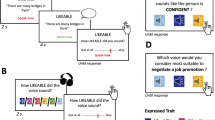Abstract
Videotapes were made of opposite-sex pairs of students in conversation with one another who had been asked to discuss items from an attitude questionnaire on which they had disagreed. At the end of the conversation, the subjects were asked to replay the videotape and to indicate which body movements of themselves and their partners they considered conveyed emphasis; these movements were then categorized using a detailed body movement system. In a second procedure, the occurrence of vocal stress was scored, together with the associated body movements. The results showed that whereas a wide diversity of primarily hand/arm movements were selected by the subjects as communicating emphasis, it was movements of all parts of the body which were related to vocal stress. It was concluded that a close relationship does exist between body movement and tonic stress, and that this can only be effectively appreciated through a body movement scoring system which enables a detailed description to be given of the visual and temporal relationship between body movement and phonemic clause structure.
Similar content being viewed by others
References
Birdwhistell, R.L.Kinesics and context. Allen Lane, the Penguin Press, 1971.
Bull, P.E.The social functions of speech-related body movement. SSRC End-of-grant report HR 6404/2, 1981.
Condon, W.S. & Ogston, W.D. Sound film analysis of normal and pathological behavior patterns.Journal of Nervous and Mental Disease, 1966,143, 338–347.
Dittman, A.T. & Llewellyn, L.G. Body movement and speech rhythm in social conversation.Journal of Personality and Social Psychology, 1969,11, 98–106.
Efron, D.Gesture and environment. New York: King's Crown Press, 1941.
Ekman, P. & Friesen, W.V. The repertoire of non-verbal behavior: categories, origins, usage and coding.Semiotica 1969,1, 49–98.
Ekman, P. & Friesen, W.V. Hand movements.Journal of Communication, 1972,22, 353–374.
Freedman, N. & Hoffman, S.P. Kinetic behavior in altered clinical states: approach to objective analysis of motor behavior during clinical interviews.Perceptual and Motor Skills, 1967,24, 527–539.
Halliday, M.A.K.A course in spoken English: intonation. Oxford University Press, 1970.
Kenon, A. Some relationships between body motion and speech. In A.W. Siegman & B. Pope (Eds.),Studies in dyadic communication, pp. 177–210. New York: Pergamon, 1972.
Kraemer, H.C. & Jacklin, C.N. Statistical analysis of dyadic social behavior.Psychological Bulletin, 1979,86, 217–224.
Lindenfeld, J. Verbal and non-verbal elements in discourse.Semiotica, 1971,3, 223–233.
Morris, D. et al.Gestures: their origins and distribution. Jonathan Cape, 1979.
Pittenger, R.E., Hockett, C.F. & Danehy, J.J.The first five minutes: a sample of microscopic interview analysis. Ithaca, New York: Martineau, 1960.
Scheflen, A.E. The significance of posture in communication systems.Psychiatry, 1964,27, 316–331.
Scheflen, A.E.Communicational structure: analysis of a psychotherapy transaction. Bloomington: Indiana University Press, 1973.
Trager, G.L. & Smith, H.L., Jr.An outline of English structure (Studies in linguistics: occasional papers, 3). Norman, Okla: Battenberg Press, 1951. (Republished: New York: American Council of Learned Societies, 1965).
Wiener, M. et al. Non-verbal behavior and non-verbal communication.Psychological Review, 1972,79, 185–214.
Rights and permissions
About this article
Cite this article
Bull, P., Connelly, G. Body movement and emphasis in speech. J Nonverbal Behav 9, 169–187 (1985). https://doi.org/10.1007/BF01000738
Issue Date:
DOI: https://doi.org/10.1007/BF01000738




